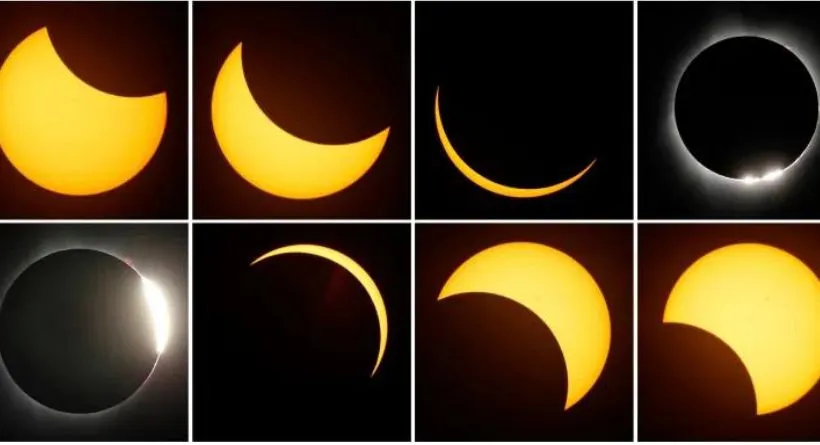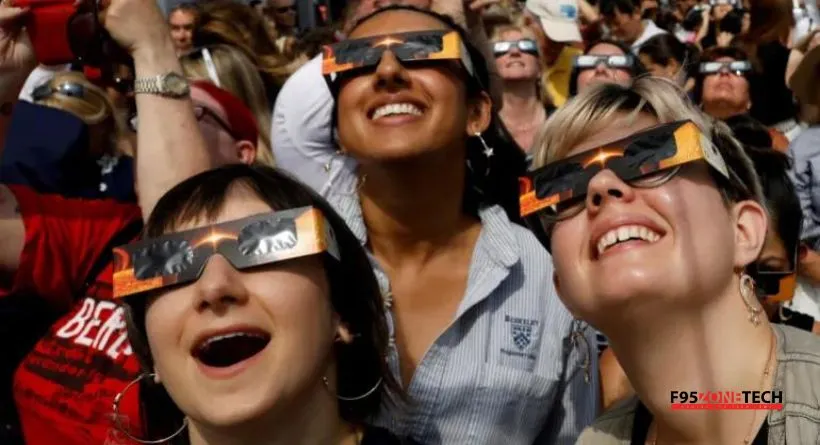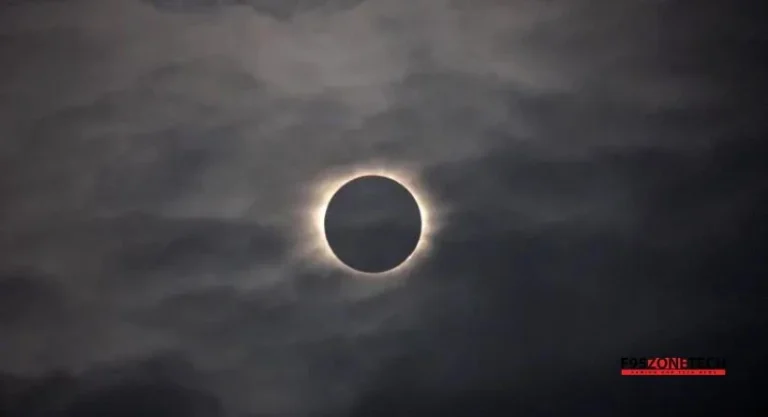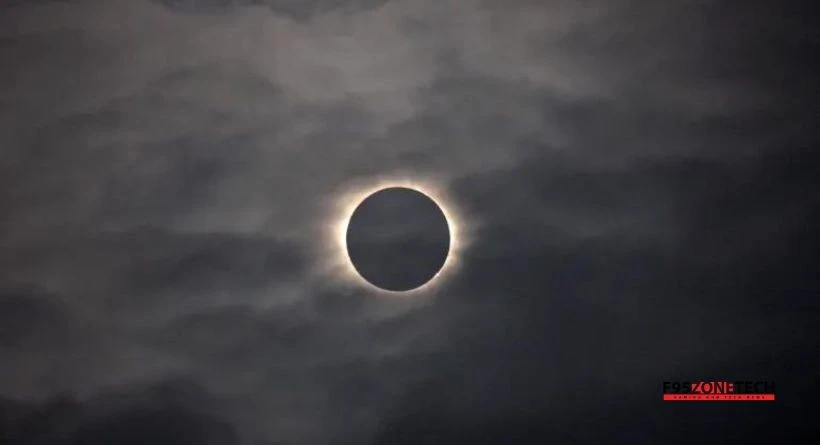On April 8, people in North America can see a total solar eclipse, in which the moon obscures the sun.
Table of contents
- Where will the total eclipse be visible from, and at what time?
- What happens during a total solar eclipse?
- What does a total eclipse look like?
- What else happens during the moment of totality?
- How long will the total solar eclipse last on April 8?
- What are some of the cultural and historical beliefs around total solar eclipses?
- Can you watch a total solar eclipse without glasses?
- How are people preparing?
- How often does a total solar eclipse happen?
- When is the next total solar eclipse?
On Monday, millions of people in North America will have the opportunity to see a unique natural phenomenon as a total solar eclipse will be visible from various locations in Mexico, the US, and Canada.
The US space agency NASA states that during a total eclipse, when the moon looks out the sun, the sky would darken for a short while “as if it were dawn or dusk.”
It will be seen from what is called the “path of totality,” a band that is 185 km (115 mi) broad and extends from the western coast of Mexico across the US and up to the easternmost province of Newfoundland and Labrador in Canada.
On its website, NASA states that “people along the path of totality, weather permitting, will see the sun’s corona, or outer atmosphere, which is usually obscured by the bright face of the sun.”
According to Anthony Aveni, an emeritus professor at Colgate University in New York and the author of the book In the Shadow of the Moon: The Science, Magic, and Mystery of Solar Eclipses, the path of totality is truly “where it’s at” on Monday.
He said to Al Jazeera, “It’s that precious three minutes… of totality when you see a whole range of phenomena that you just don’t see in everyday life.” “You stop what you’re doing and stare in awe at nature because it takes your breath away.”
How frequently do total solar eclipses happen then? How much time does it usually last? How and where can you view without risk? Everything you require is provided here.
Where will the total eclipse be visible from, and at what time?
The complete eclipse on Monday will be visible from several US, Canada, and Mexico locations.
At 11:07 a.m. local time (18:07 GMT), it will cross into continental North America at Mazatlan, in the northwest Mexican state of Sinaloa. At 5:16 p.m. local time (19:46 GMT), it will cross the continent on Canada’s Atlantic coast near Newfoundland.
The eclipse will cross into Texas at 1:27 p.m. local time (18:27 GMT) and emerge from Maine in the United States at 3:35 p.m. local time (19:35 GMT).
It will only last a few minutes, and depending on your location along the path of totality, you can determine exactly when it will be visible.
For instance, totality begins at 3:16 p.m. local time (19:16 GMT) and concludes at 3:20 p.m. (19:20 GMT) in Erie, Pennsylvania.
A few minutes later, it will arrive in Buffalo, New York, where totality begins at 3:18 p.m. local time (19:18 GMT) and concludes at 3:22 p.m. (19:22 GMT).
Monday’s eclipse will also be partially visible for almost two hours, both before and after totality.
What happens during a total solar eclipse?
The moon travels around Earth once a month in addition to the Earth’s orbit around the sun.
A total solar eclipse occurs when the moon passes directly in front of the sun, completely obstructing its light on one side and throwing a shadow on a tiny portion of the planet on the other.
The moon’s orbit is shaped like a narrow “path” or track by the dark inner region of the shadow, called the “umbra.” The regions where the total eclipse may be seen are those along this route that are immediately beneath the shadow, particularly along its centerline.
This track is 16,000 km (10,000 miles) long and around 160 km (100 miles) broad.
“If it was a lunar eclipse, it would be seen by people all around the world for a few hours. However, complete eclipses only occur in a particular path of the new moon, according to NASA eclipse envoy Khady Adama Ndao.
Only on a fresh moon does this eclipse happen. What causes a complete eclipse is the moon’s orbital location around the sun, Earth, and all three at a particular moment in time.
During an eclipse, the moon will appear to be completely covered by Earth, but in actuality, the moon is 400 times smaller than the sun. The moon seems to be large enough to cover the sun during a complete eclipse due to the increased distance between the moon and the sun.
On Monday, those who are not in the direct line of totality but are nearby may be able to experience a partial eclipse. At that point, the moon just partially blocks the sun.
A partial eclipse can be seen in areas that are partially covered by the “penumbra,” or dim portions of the moon’s larger shadow.
What does a total eclipse look like?
During an eclipse, the moon will gradually block the sun, resulting in a black sky, until it reaches the point of “totality.” At that point, the sun will nearly completely obscure itself, leaving only the corona, or faint ring of light, visible.
The moon will move away after a few minutes, causing those in the path of totality to witness another partial eclipse. The sun will once more be completely visible.
What else happens during the moment of totality?

The temperature drops, and animals begin to act more like they are in the night.
Birds may start to vary their chirping habits, and nocturnal creatures like owls and bats may begin to wake up and seek food.
It might also become easier to see stars and other celestial objects become in the black sky.
A black shadow would be visible traveling over Earth if one were to stand on the moon or a space station circling the planet.
How long will the total solar eclipse last on April 8?
From the time the moon first covers the sun until it passes over and stops doing so, a total solar eclipse can last anywhere from two to three hours.
But in most locations this year, the totality phase will only last three and a half to four minutes.
The lengthiest duration of totality will occur in places that are on or very near the centerline, while areas further from the centerline will experience lesser durations of totality.
Monday’s longest totality will last 4 minutes and 28 seconds, and it will happen close to Torreon, Mexico. This is because the region is closest to both the umbral shadow’s central line and the point at which its path is perpendicular to the surface of the Earth.
Totality has previously lasted anything from a few seconds to seven and a half minutes in various locations.
The Earth’s curvature and the angle at which the moon’s shadow impacts are two of the many reasons why the eclipse and the period of totality have different lengths.
Applications for smartphones, like “Totality,” track the start and end timings of eclipses as well as the lengths of totality for various towns along the line of the complete eclipse.
What are some of the cultural and historical beliefs around total solar eclipses?
People have been fascinated by total solar eclipses for thousands of years. However, the event was frequently seen as a terrible omen in ancient civilizations.
According to NASA, inhabitants in ancient China, for instance, thought that solar eclipses occurred because “a celestial dragon” was consuming the sun. Consequently, during eclipses, people would yell “to frighten the dragon away.”
Solar eclipses, according to the Inca people of South America, were an indication of Inti, the sun deity, being angry.
Furthermore, a solar eclipse was believed to be a warning that the monarch of ancient Mesopotamia (modern-day Iraq) was in danger, which prompted policymakers to institute the “substitute king” system.
For example, to ensure that the real Assyrian king was spared harm, a stand-in would be clothed and ultimately sacrificed as a sacrifice “for the evil fate that was destined for the true king,” according to curator Sarah Graff of the Metropolitan Museum of Art in New York City.
Individuals tend to think that individuals in the past were less intellectual or more superstitious about eclipses than those in the present, according to Aveni at Colgate University. “But it’s an opportunity to have a conversation in every situation,” he said to Al Jazeera.
To “alert the sun not to believe what the moon is whispering in his ear, which is that we people that live down here on Earth do bad things at night,” for example, people in the ancient Andean world made noise during an eclipse, according to Aveni. “This turns into an opportunity to talk about lying; that’s the main focus of the conversation.”
Can you watch a total solar eclipse without glasses?
Experts emphasize how important safety is.
People may see a total eclipse with their unaided eyes during a brief period when the moon obscures the sun.
However, you should utilize a portable solar viewing apparatus or specially-made protective sunglasses during the partial eclipse that occurs both before and after totality.
“People could hurt their eyes if they look without the right protection,” stated B Ralph Chou, president of the Royal Astronomical Society of Canada.
“And if they get hurt, they do have a significant risk of developing a permanent loss of vision, depending on how often and for how long they look at the sun without protection.”
The sun’s rays and intensity, in addition to the absence of pain receptors in the eye, which facilitates prolonged staring, are some of the variables that contribute to this risk.
Pupils may also be less dilated during an eclipse than on a typical day, which increases the threat of the intense light entering. Ndao, the NASA eclipse ambassador, described it as “like being in the dark when suddenly, someone just flashes a flashlight in front of your eyes.”
How are people preparing?

Residents in the towns and cities that fall under the path of totality have been given eclipse glasses in the weeks preceding Monday’s event. Various organizations such as scientific institutes and museums are hosting viewing parties.
Monday’s school closures in the US and Canada were announced to allow pupils to take part in eclipse-viewing programs. In addition to preventing safety hazards, schools have expressed worry over the eclipse falling on a school day when classes are supposed to be out.
According to Barbara Gruber, assistant director of education and public outreach at the National Radio Astronomy Observatory (NRAO) in the US, groups of individuals are also traveling in private aircraft to witness the totality.
The US Federal Aviation Authority has issued safety recommendations against flying during totality, even though this is allowed.
How often does a total solar eclipse happen?
While a total solar eclipse usually happens every 18 months, Monday may be the final eclipse to occur in the United States for at least another nine years.
According to Ndao, many complete eclipses are only visible from the water and might not be viewed by anybody at all.
Furthermore, after a total eclipse occurs in a certain region, the phenomena cannot repeat for hundreds of years.
According to Gruber, “averages can be misleading and some lucky places will get an eclipse in just a few years.” A total solar eclipse occurs in a single site around every 350 years.
When is the next total solar eclipse?
August 12, 2026, will see the next complete solar eclipse across Iceland, Spain, and Greenland. On August 2, 2027, almost precisely a year later, one will be visible from the Saudi peninsula, Gibraltar, and northern Africa.
The next complete eclipse in the United States will happen in 2033, although it will only be seen from Alaska.
According to NRAO, a total eclipse will be visible in North Dakota, Montana, and Western Canada in 2044. The US will be able to observe a total eclipse from coast to coast in the following year.
However, experts predict that complete eclipses will eventually cease to occur entirely, but not for some time to come.
The moon will someday grow too tiny in the sky to completely enclose the sun as the cosmos expands and the moon moves further from Earth each year.
However, that day is still far off. According to a 2017 NASA research, complete eclipses will cease in 563 million years.








